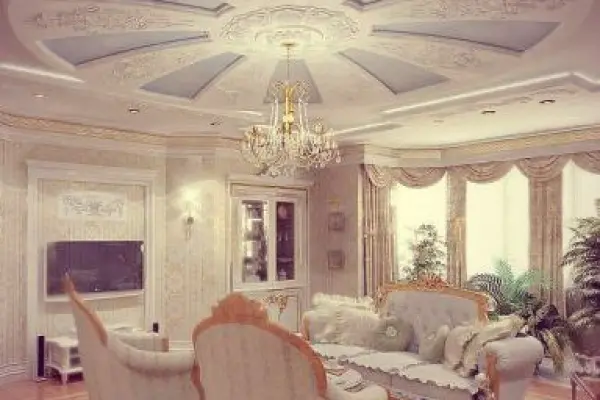Decorative ceiling medallions have become a true trend in modern design. The cost of quality products starts at $15. In my experience working with private clients, I’ve noticed that a well-chosen ceiling medallion for a chandelier can visually increase the height of a room, which is especially relevant for standard apartments with 2.7-meter ceilings.
The price range is impressive — from budget-friendly $15 to exclusive $200. What accounts for such a difference? Material, intricacy of the pattern, and size. It’s worth noting that high-quality handmade plaster ceiling medallions can cost more than the chandelier they’re installed under.
“When choosing a ceiling medallion, remember: it should be no more than 2/3 the diameter of the chandelier. This golden rule of proportions never fails,” advises an interior designer with 15 years of experience.
History of Ceiling Medallions: From Palaces to Modern Homes
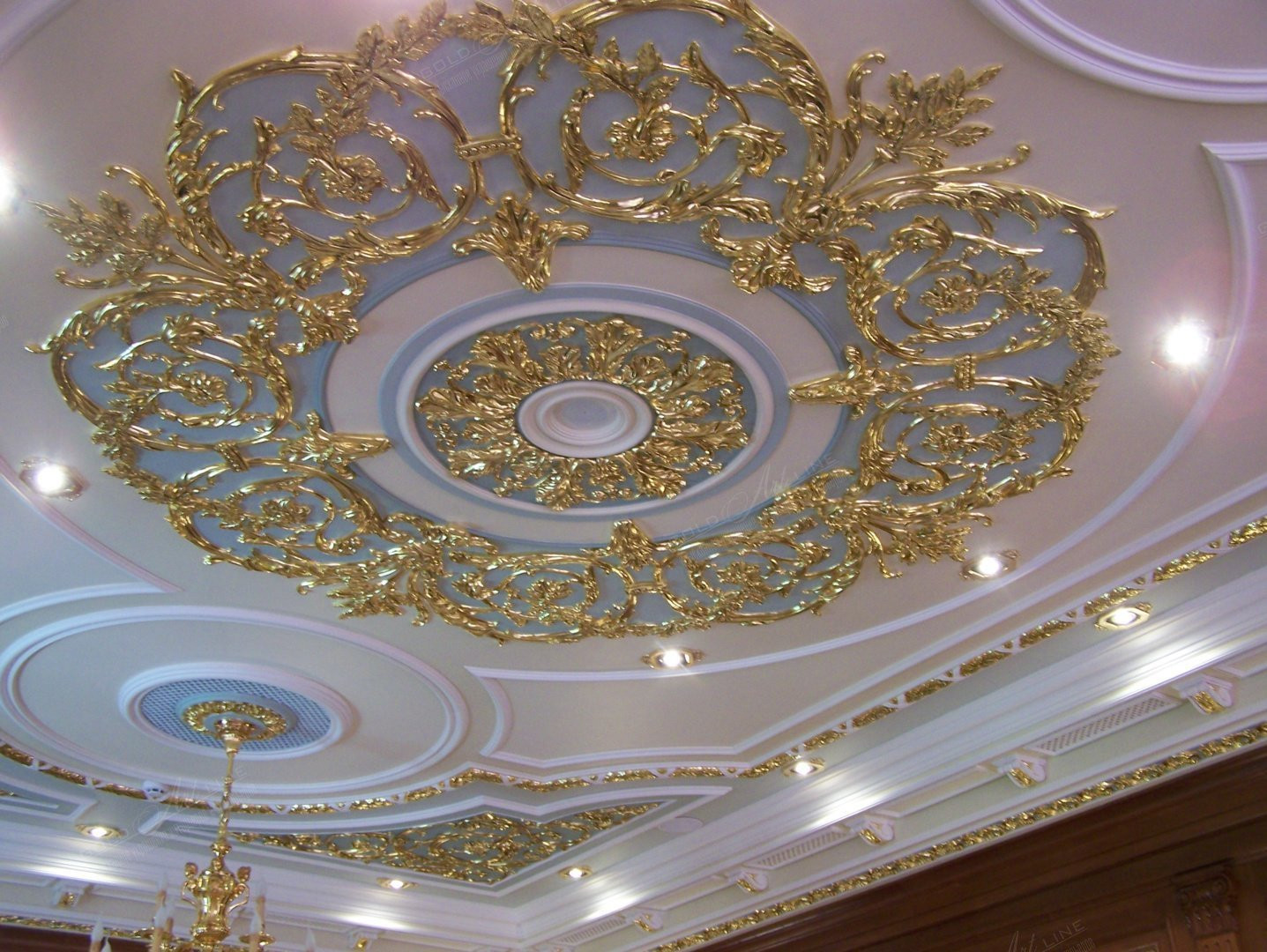 Ceiling medallions originated in ancient times. Ancient Romans and Greeks adorned the ceilings of temples and palaces with circular medallions. Craftsmen created them by hand, using local materials and traditional techniques.
Ceiling medallions originated in ancient times. Ancient Romans and Greeks adorned the ceilings of temples and palaces with circular medallions. Craftsmen created them by hand, using local materials and traditional techniques.
The Middle Ages partially lost these traditions. The Renaissance of the 14th–17th centuries revived interest in classical forms. It is known that some medallions in Versailles contained up to 300 decorative elements, each molded separately.
The Victorian era made decor accessible to the middle class. Modern technologies have gone further. Now you can buy ceiling medallions that look antique but cost significantly less.
Materials for Ceiling Medallions: Comparison and Selection
The choice of material determines everything. Durability, appearance, and installation cost — every aspect depends on what the decorative medallion is made of. Let’s explore the three main options offered by the architectural decor market.
Plaster Ceiling Medallions
Classic never goes out of style. Plaster medallions allow for the creation of highly detailed ornamental designs with the finest elements of molded decor. The weight of standard products ranges from 0.8 to 3 kg, depending on the diameter and complexity of the pattern.
In one project last season, we had to reinforce the ceiling structure for an exceptionally large medallion weighing 4.5 kg with an 85 cm diameter. However, its durability is impressive: original interior moldings from 18th-century European mansions are still preserved today.
Polyurethane Decorative Medallions
Polyurethane molding is a revolution in the world of decor. Modern polyurethane medallions are 5–10 times lighter than plaster counterparts while maintaining pattern detail. They are moisture-resistant, making them an ideal choice for bathrooms and kitchens.
Thus, if you need durability at a reasonable price, polyurethane is the optimal solution. Prices range from $25 to $80, making this material accessible for most projects.
Choosing isn’t always easy, but it’s effective. Modern studies show that polyurethane molding conditions critically affect the final properties of the products.
Polystyrene Medallions
The budget segment has its place. Prices start at $15, allowing you to order ceiling medallions even on a minimal budget. Ease of installation is the main advantage of this material.
Polystyrene is highly moisture-resistant and practically does not absorb water. Its lifespan is limited to 5–7 years with active use, but it’s a perfectly acceptable option for temporary decor or rental properties.
Installation Features for Stretch Ceilings
Stretch ceilings require a special approach — like delicate silk, they don’t tolerate rough handling. Lightweight polyurethane and polystyrene medallions can be glued directly onto the stretch fabric using special adhesive. Use compounds free of aggressive solvents for this purpose.
In my work with private clients, it’s important to note that heavy plaster medallions cannot be installed on stretch ceilings — the fabric won’t withstand the load. In such cases, lightweight material imitations are used.
Recommended Adhesive Brands for Medallions
The quality of the adhesive determines the longevity of the medallion’s attachment. Here are proven options for each material type:
- For polyurethane: Titebond Polyurethane Glue, 3M 5200
- For plaster: Perlfix (Knauf), G-5 construction plaster
- For polystyrene: Moment Installation, Liquid Nails LN-704
Using high-quality adhesive ensures secure attachment for 10–15 years.
Below is a comparative table of the main characteristics of materials for budget and premium ceiling medallions.
| Material | Price ($) | Weight (kg) | Lifespan (years) | Moisture Resistance |
|---|---|---|---|---|
| Plaster | 35-200 | 0.8-3 | 50+ | Low |
| Polyurethane | 15-120 | 0.3-1.5 | 25-30 | High |
| Polystyrene | 8-40 | 0.1-0.5 | 5-7 | High |
These data will help you choose a material based on your budget and durability requirements.
How to Choose the Right Ceiling Medallion Size
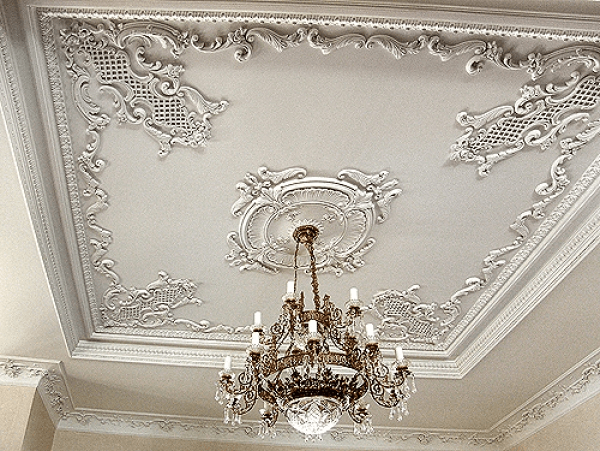 The size of ceiling medallions is the foundation of a harmonious interior. An overly large medallion will overwhelm the space, while one too small will get lost among the decor.
The size of ceiling medallions is the foundation of a harmonious interior. An overly large medallion will overwhelm the space, while one too small will get lost among the decor.
In a recent project, a client insisted on a 120 cm diameter medallion for a 3×4 meter room. The result was comical — the ceiling seemed to “collapse” under the weight of the decor, even though the medallion physically weighed only 800 grams.
Proper selection is about balancing the ceiling area, room height, and chandelier dimensions. For a standard 16–20 m² room with 2.7–3 m ceilings, medallions with a 40–60 cm diameter are optimal. This is a time-tested proportion for modern apartments.
“Designer James Carter from New York worked on a $2 million penthouse project. Initially, simple finishes were planned, but the client saw a sketch with ceiling medallions. The result exceeded expectations: four 80 cm polyurethane medallions with lighting transformed the living room into a work of art. The decor cost only $320, but the effect was comparable to expensive moldings.”
Impact on Spatial Perception
Classic ceiling medallions can dramatically change a room’s perception. Large medallions with bold relief create a sense of luxury but visually lower the ceiling.
Minimalist models, on the other hand, add airiness. Light-colored medallions visually expand the space, while darker ones make it cozier.
Practical Rule: For rooms up to 20 m² with ceilings up to 3 m, use medallions no larger than 50 cm in diameter. Violating this proportion creates a subconscious sense of discomfort.
How to Install a Ceiling Medallion Yourself: Step-by-Step Guide
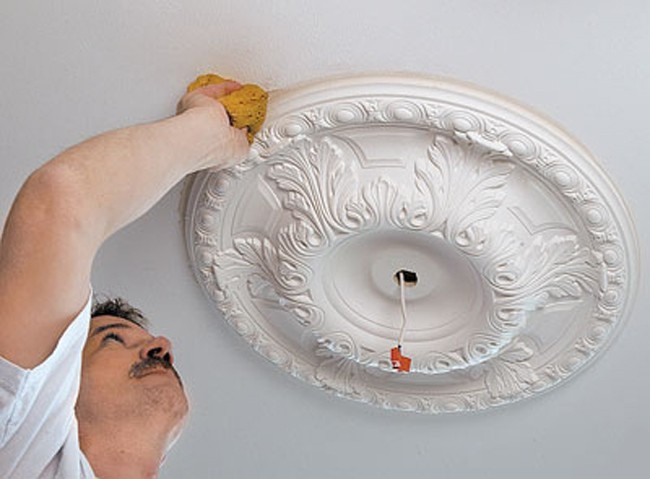 Installing a medallion on the ceiling is a process requiring millimeter precision. A 2–3 cm error can ruin the entire composition, especially in small spaces. Experienced craftsmen often discuss the correct sequence: mounting element first or medallion first.
Installing a medallion on the ceiling is a process requiring millimeter precision. A 2–3 cm error can ruin the entire composition, especially in small spaces. Experienced craftsmen often discuss the correct sequence: mounting element first or medallion first.
Safety and Electrical Work
Working with electricity demands strict adherence to safety measures. Negligence is unacceptable. Before starting work, always turn off the power at the breaker and verify the absence of voltage with a tester.
When installing a medallion around a chandelier, take the following steps:
- Remove the chandelier and insulate the wires
- Ensure the ceiling hook is securely fastened
- Reinforce the mounting point if necessary
- Route wires to avoid interference with the medallion installation
Following these rules eliminates the risk of electric shock and wiring damage.
Common Installation Mistakes
In practice, I often notice that even experienced craftsmen sometimes make mistakes that can ruin the result. Here are the most common errors in ceiling medallion installation:
- Incorrect center marking - use a laser level or stretch diagonal threads
- Inadequate surface preparation - dust and grease significantly reduce adhesive strength
- Uneven adhesive application - this leads to detachment within 1–2 years
- Rushing the installation - adhesive needs time for initial bonding
- Ignoring the medallion’s weight - elements heavier than 2.5 kg require additional dowel fixation
Avoiding these mistakes ensures a quality result that lasts decades.
Tools and Materials for Medallion Installation
Prepare everything needed in advance for a quality installation:
- Special adhesive for the chosen material
- Tape measure and builder’s level
- Pencil for marking
- Paintbrush (for plaster medallions)
- Ladder of appropriate height
A complete set of tools saves time and ensures a professional result.
Step-by-Step Installation Process for a Decorative Medallion
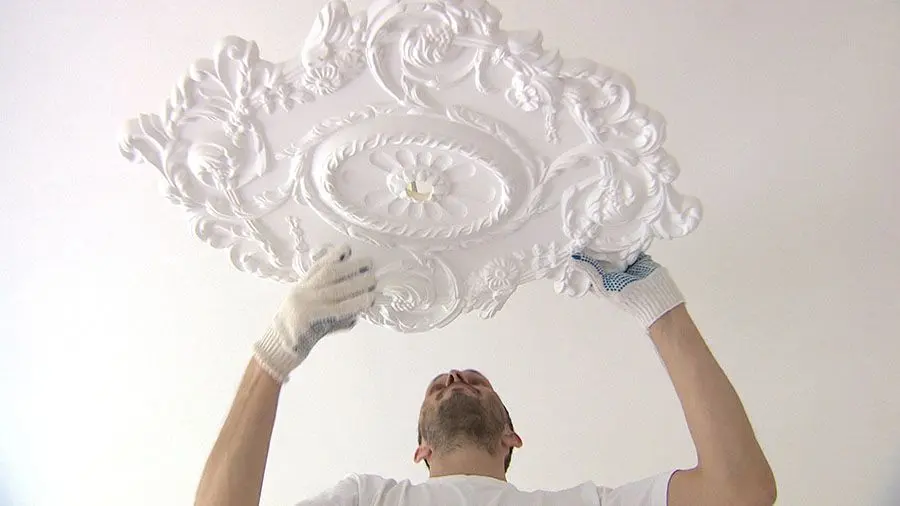 The correct sequence of actions is key to successful installation. Each step matters. Consider the medallion material and ceiling surface type:
The correct sequence of actions is key to successful installation. Each step matters. Consider the medallion material and ceiling surface type:
- Surface preparation. The ceiling must be clean and even. Eliminate any irregularities over 2 mm. Treat porous surfaces with a deep-penetrating primer.
- Product acclimatization. Allow polyurethane medallions to sit in the room for 2–3 hours at room temperature, especially in winter.
- Center marking. Find the intersection of the room’s diagonals — this is the geometric center.
- Test fitting. Place the medallion on the ceiling and check its symmetry relative to the walls.
- Adhesive application. Apply evenly across the entire back surface of the medallion.
- Installation. Press the medallion to the ceiling and hold for 30–60 seconds for initial bonding.
- Finishing. Remove excess adhesive and touch up joints if needed.
Following this guide, even a beginner can install a medallion professionally.
“Remember: quality adhesive is 50% of installation success. Skimping on materials can lead to the medallion falling and damaging the chandelier,” warns a craftsman with 20 years of experience.
Ceiling Medallion Styles and Their Use in Interiors
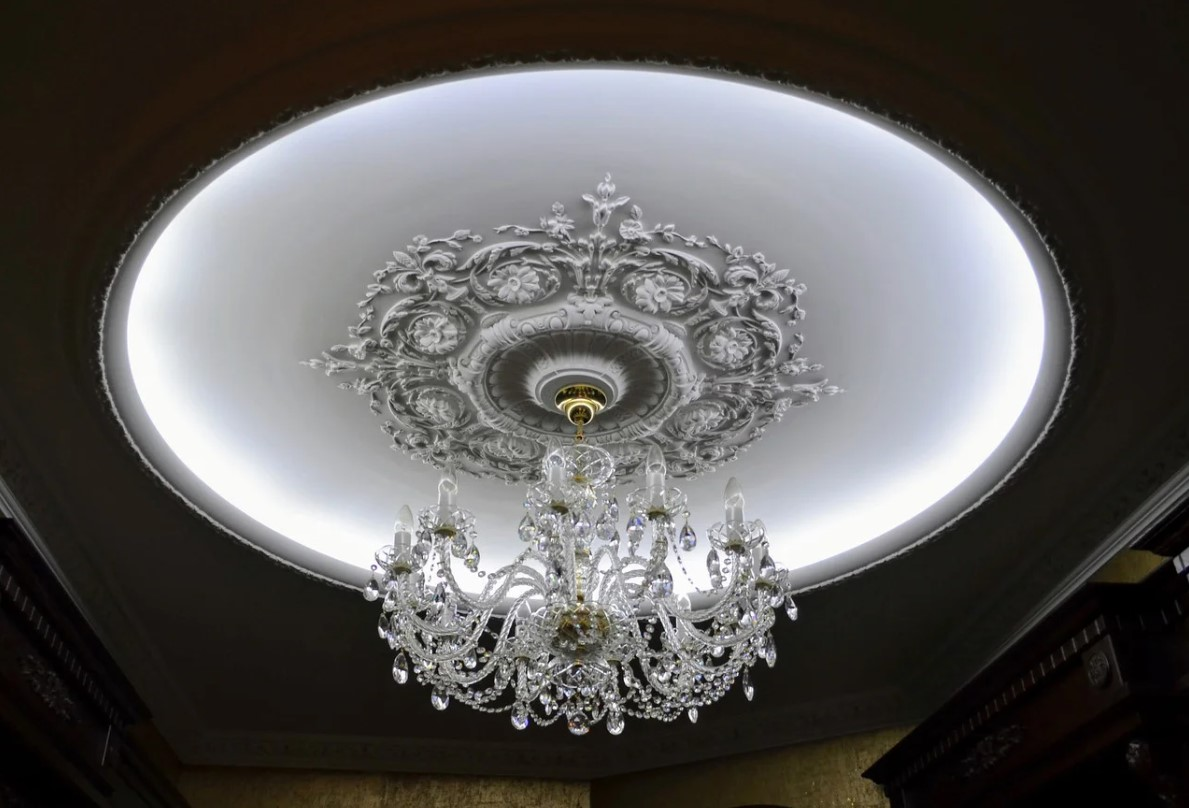 Each style sets its own rules. Baroque demands opulence, minimalism — simplicity. But what about modern eclecticism, blending eras like a cocktail of different ingredients?
Each style sets its own rules. Baroque demands opulence, minimalism — simplicity. But what about modern eclecticism, blending eras like a cocktail of different ingredients?
Classical Styles
Classical styles never go out of fashion and suit most interiors. Thus, choosing traditional ceiling decor is an investment in timeless design:
- Baroque and Rococo: Characterized by luxury and abundant decorative elements, featuring floral motifs, acanthus scrolls, and gilding.
- Classicism: Defined by complex but symmetrical patterns, with geometric ornaments and laurel wreaths being popular.
- Empire: Military themes, eagles, laurel wreaths, and strict symmetry.
These styles create an atmosphere of grandeur, ideal for formal spaces.
Modern Trends
Modern styles cater to minimalism and functionality. In a recent project, a client wanted “something classic but not boring” — a perfect description of the modern approach to traditional decor:
- Minimalism: Simple, clean lines without excessive details, with concentric circles being popular.
- Contemporary: A blend of styles, allowing eclectic solutions.
- Loft: Rough textures, imitating metal or concrete.
Such stylized medallions are perfect for urban apartments and office spaces.
Pairing with Cornices and Moldings
Ceiling molding works like an orchestra — each element must complement the others. Overlay medallions pair beautifully with decorative cornices of the same material and style, creating a cohesive composition.
In practice, I often notice that trying to save money by using elements from different manufacturers leads to disharmony. It’s better to buy a set from one brand to ensure matching shades and textures.
Modern Trends
In recent years, geometric patterns and medallions with integrated LED lighting have gained popularity. This solution turns a decorative element into an additional light source. The cost of such systems starts at $85.
Modern design concepts are so versatile that they allow ornamental medallions to be used even for wall decoration. The main advantage is low cost with impressive results.
Where to Buy a Ceiling Medallion: A Buyer’s Guide
You can buy ceiling medallions in specialty stores or online. The price of ceiling medallions depends on many factors, but where can you reliably find quality products?
Online stores for ceiling medallions offer convenience and a wide selection. However, inspecting an item in a showroom allows you to assess the quality of the molding firsthand. Considering the specifics of purchasing decorative elements, I recommend a combined approach: explore the range online and make the final choice in person.
What to Look for When Buying
When selecting a medallion in a store or online, pay attention to the following quality criteria for architectural decor:
- Casting quality. Clarity of ornamental details
- No defects. No cracks, chips, or irregularities
- Size accuracy. Verify the measurements
- Completeness. Check for instructions and mounting hardware
Thoroughly checking these parameters helps avoid disappointment and extra costs.
“When buying online, always read reviews and request additional photos. The image on the website can differ significantly from reality,” advises an experienced decorator.
During sales periods, you can find quality products with discounts on ceiling medallions up to 40%. Many manufacturers offer ceiling medallions with delivery, which is especially convenient for large orders.
Ordering ceiling medallions in bulk is cost-effective when decorating multiple rooms. Installation costs range from $12 to $45, depending on the complexity, material, and region.
Maintenance and Care for Ceiling Medallions
Proper care extends the lifespan of molding elements for years. Consider the characteristics of each material and the room’s operating conditions.
Regular Maintenance
Simple care rules will help preserve the medallion’s original appearance for years:
- Dust: Clean with a soft brush or vacuum with a nozzle monthly
- Wet cleaning: For polyurethane medallions only, use a slightly damp sponge
- Plaster medallions: Dry cleaning only; for heavy soiling, restoration is needed
Regular maintenance extends the decor’s lifespan several times over.
Restoration and Repainting
Repainting is recommended every 5–7 years. Use water-based acrylic paints — they are non-toxic and easy to apply. Before painting, clean the surface and apply a primer for better adhesion.
In practice, I often notice that owners underestimate the importance of quality primer, leading to paint peeling within a year or two of repainting.
Checklist: How to Choose the Perfect Ceiling Medallion
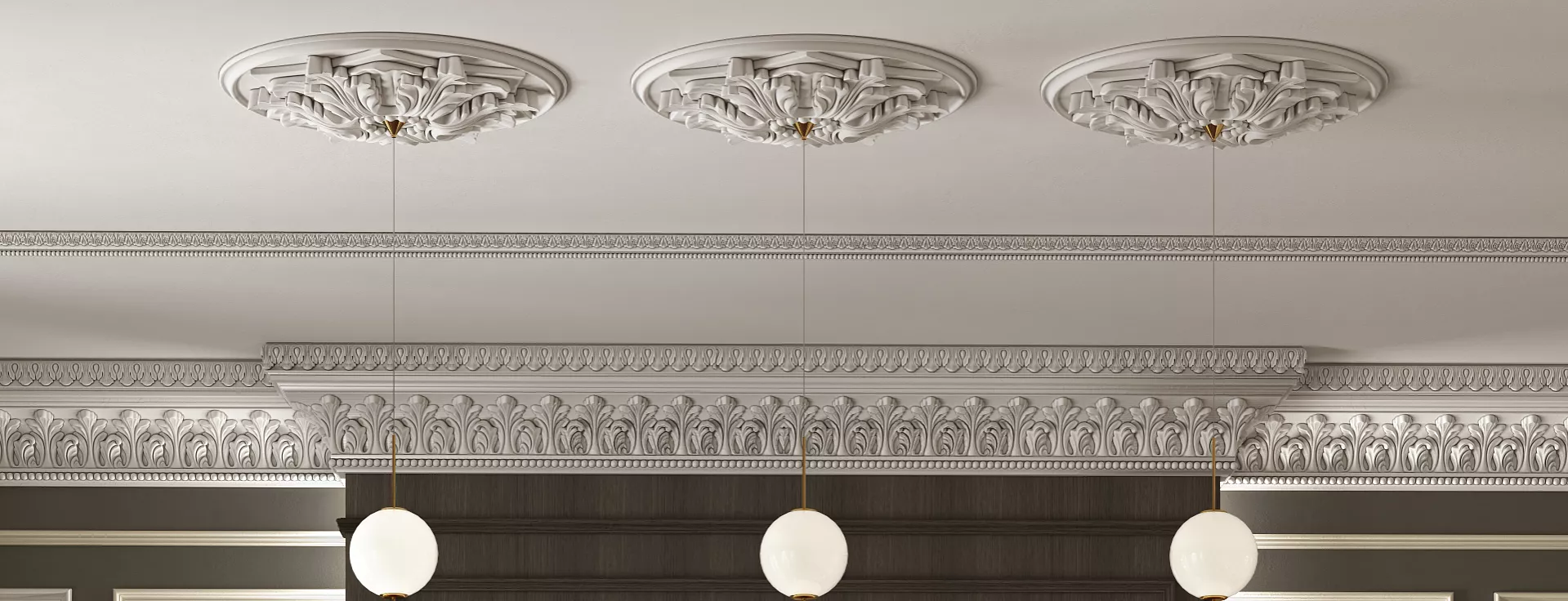 This step-by-step plan will help you avoid mistakes and get exactly what you need for your interior:
This step-by-step plan will help you avoid mistakes and get exactly what you need for your interior:
- Assess the interior style - the medallion should harmonize with the overall design
- Measure the room - for rooms up to 20 m², choose medallions up to 50 cm
- Consider chandelier size - medallion = 2/3 of the light fixture’s diameter
- Choose the material - polyurethane is versatile, plaster for classics
- Set a budget - from $15 (polystyrene) to $200 (handmade plaster)
- Evaluate installation complexity - heavy medallions require professional installation
Following this checklist ensures you’ll choose a medallion that will delight you for years.
Besides concealing imperfections, when properly combined with moldings, cornices, and other interior molding elements, decorative ceiling medallions give a room a polished look. They highlight aristocratic elegance, refined richness, and the structure of the room’s style. Incorporating volumetric decorative elements into the overall composition creates top-tier, multi-level ceiling decor.
